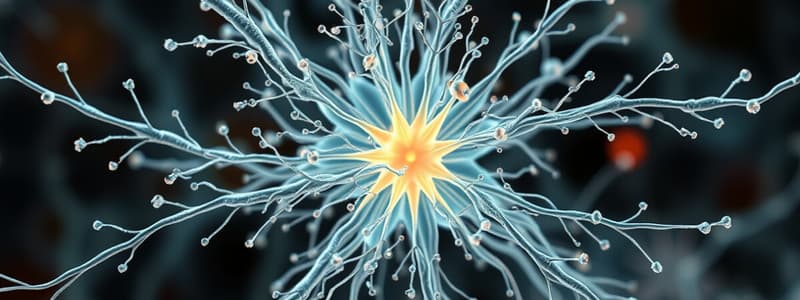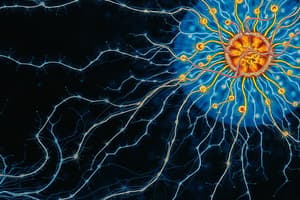Podcast
Questions and Answers
What primary function do microfilaments serve in animal cells during cell division?
What primary function do microfilaments serve in animal cells during cell division?
- Creating spindle fibers
- Storing genetic material
- Establishing cell structure
- Forming the cleavage furrow (correct)
Which of the following organelles is responsible for the red, orange, and yellow coloring in fruits and flowers?
Which of the following organelles is responsible for the red, orange, and yellow coloring in fruits and flowers?
- Chromoplasts (correct)
- Chloroplasts
- Leucoplasts
- Mitochondria
What is the primary function of chloroplasts in plant cells?
What is the primary function of chloroplasts in plant cells?
- Cellular respiration
- Protein synthesis
- Photosynthesis (correct)
- Storing starch
What components make up the phospholipid bilayer of the cell membrane?
What components make up the phospholipid bilayer of the cell membrane?
Which of these structures is NOT a function of microtubules?
Which of these structures is NOT a function of microtubules?
How do leucoplasts differ from chloroplasts?
How do leucoplasts differ from chloroplasts?
What is the role of centrioles in animal cells?
What is the role of centrioles in animal cells?
Which part of the cell membrane is characterized as hydrophilic?
Which part of the cell membrane is characterized as hydrophilic?
The cellular structure responsible for the movement of organisms like amoebas is primarily made up of which protein?
The cellular structure responsible for the movement of organisms like amoebas is primarily made up of which protein?
Flashcards are hidden until you start studying
Study Notes
Cytoskeleton
- Composed of a complex network of protein filaments throughout the cytoplasm.
- Provides structural support, determines cell shape, and enables cell movement.
Microtubules
- Formed from tubulin protein.
- Essential components of cilia, flagella, and spindle fibers during cell division.
Microfilaments
- Composed of actin protein.
- Functions include:
- Formation of the cleavage furrow in animal cells during division.
- Movement of amoebas via pseudopodia.
- Contraction of skeletal muscles through interaction with myosin.
- Located outside the nucleus, organizing spindle fibers for cell division.
- Centrioles, made of microtubules and microfilaments, support cellular structure and movement.
Plastids
- Chloroplasts:
- Contain chlorophyll, giving them a green color.
- Site of photosynthesis, converting sunlight into energy.
- Possess their own genetic material and can replicate independently.
- Found in the green parts of plants and algae.
- Leucoplasts:
- Colorless and primarily store starch.
- Commonly located in roots (e.g., turnips) and tubers (e.g., potatoes).
- Chromoplasts:
- Store carotenoid pigments responsible for red, orange, and yellow colors.
- Bright pigments in flowers attract pollinators.
Cell Membrane
- Semi-permeable barrier controlling the movement of substances in and out of the cell.
- Composed of a phospholipid bilayer:
- Head: Contains phosphate, hydrophilic (water-attracting).
- Tail: Comprised of lipids, hydrophobic (water-repelling).
Studying That Suits You
Use AI to generate personalized quizzes and flashcards to suit your learning preferences.



